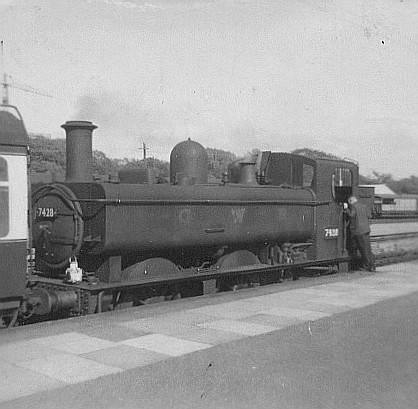- GWR 6400 Class
Infobox Locomotive
powertype=Steam
name = GWR 6400 and 7400 Classes
caption = The Aberystwythstation pilot , 7428, still lettered GWR
13 years after nationalisation, 1 August 1961 the year before withdrawal
designer = Collett
builder = GWR 6400 and 30 7400; BR 20 7400
builddates = 6400, 1932 (40)
7400, 1936 (30), 1948 (10), 1950 (10)
totalproduction = 6400, 40
7400, 50
whytetype = 0-6-0PT
gauge = 4' 8½"
leadingsize =
driversize = 4' 7½"
length =
weight = 6400, 45 tons 12 cwt,
7400, 45 tons 9 cwt
fueltype = coal
fuelc
waterc
cylindercount = two inside
cylindersize = 16½"x24"
firearea =
boilerpressure = 6400-165 psi; 7400-180 psi
tractiveeffort = 6400-16,510 lbs; 7400-18,010 lbs
railroadclass= 6400, 2P
7400, 2F|The
Great Western Railway (GWR) 6400 Class is a class of0-6-0 pannier tank steam locomotive introduced byCharles Collett in 1932. All 40 examples were 'auto-fitted' – equipped with the remote-control equipment needed for working autotrains.The 1936 GWR 7400 Class was very similar but had no
push-pull (autotrain) apparatus, but did have a higher boiler pressure of 180 psi providing a small but useful increase in power. An initial build of 30 in 1936-1937 was added to byBritish Railways in two batches each of ten locos in 1948 and 1950. These were destined for a short life, the briefest being only nine years. A minor visual difference between the 64xx and 74xx classes was the join between the bunker and cab side. The 64xx had an arc whereas the later class was at right angles.Both classes were closely related to the 1930
GWR 5400 Class and in turn an evolution of both the Armstrong 1874GWR 850 Class and the Dean 1891GWR 2021 Class . Thus the basic design was almost sixty years old when new, the 4' 7½"driving wheel s being the main distinguishing factor, apart from the more modern profile. There were also superficial similarities with theGWR 645 Class as extant in the 1930's that also had 4' 7½" wheels and 24" stroke cylinders (and by then pannier tanks and full cabs). Strictly speaking this class was from the "larger" group of tank engines with longer wheel bases and 17" or 17½" diameter cylinders that eventually evolved into the 94xx of 1947.Overview
The smaller wheels of the 64xx's permitted operation in hillier locations than the 5400 Class and allocations were initially to the
South Wales valleys.Engines of class 6400 worked on many of the ex-GWR branch lines in
Devon andCornwall until the early 1960s, when the lines closed ordiesel multiple unit s took over services. Number 6430 was a regular engine on the old Tavistock South branch line and would often run with two autocoaches.Numbering
There were 40 locomotives in the 6400 Class, numbered 6400-6439"The Observer's Book of Railway Locomotives of Britain" by H C Casserley, Frederick Warne & Co (1958 edition)] and 50 locomotives in the 7400 Class, numbered 7400-7449
Preservation
Three of the 6400 Class have survived to preservation:
* 6412 "The Flockton Flyer"
West Somerset Railway
* 6430Llangollen Railway
* 6435 "Ajax"Paignton and Dartmouth Steam Railway References
ee also
*
GWR 0-6-0PT – "list of classes of GWR 0-6-0 pannier tank, including table of preserved locomotives"External links
;6400 Class
* [http://www.gwsr.com/html/6412.html 6412]
* [http://llanrailarchive.llangollen-railway.co.uk/sloco6430.html 6430];General
* [http://www.gwr.org.uk/nopanniers.html Guide to GWR Pannier Tank Classes]
Wikimedia Foundation. 2010.
